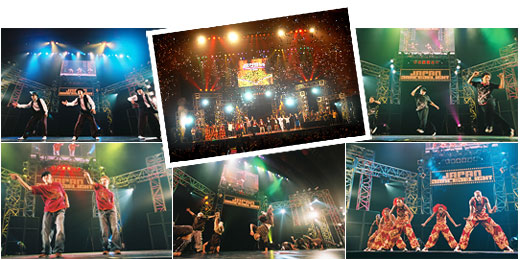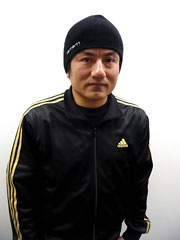|
|
|
 |
Did you know that Osaka is often recognized as the center
for street dance in Japan today?
Known for characteristic spins on the head and back, breakdance
first evolved in the 1970s among young generations of African
Americans and Latino Americans in South Bronx, New York.
In the midst of intense rivalry between street gangs, young
dancers competed with their techniques in this new style
of street dance as alternatives to violent fights. As more
acrobatic moves, such as "windmill," "headspin," and "handspin," were
created and incorporated, the popularity of breakdancing
began to spread. In 1983, the movie "Flashdance" became
a global hit and introduced breakdancing worldwide. Influenced
and motivated by the movie, many young people around the
world started "breaking."
Following the enormous success of "Flashdance," breakdancing
was featured in a number of movies as well as television
programs and commercials. The boom, however, gradually slowed
down and its popularity had chilled by the late 80s. During
this period, breakdancing evolved to a new level in Europe
as more complicated power moves and new combinations of techniques
were developed. Cultural elements were also added to the
style, from African folk dances to the Brazilian fighting
sport called capoeira. During the 90s, its popularity returned
and it became a global movement. Today, breakdancing is considered
a borderless entertainment that anyone in the world can enjoy
beyond the language barrier.
In Korea, as the new century began, highly skilled dancers
emerged one after another and performed revolutionary moves,
winning international competitions and becoming globally
famous. Today, breakdancing is one of the major national
industries. Popular teams and dancers are national idols,
are featured on various TV programs and commercials, and
draw fans to their concert shows. They act as professional
dancers by signing sponsorship contracts with major sport
brands such as Adidas and Puma. A number of theaters exclusively
present street dance performances and have become a popular
tourist attraction.

"Angel Dust Breakers"
"Angel Dust Breakers" was a breakdance team that
was popular in the 80s in Osaka. Takashi Okamura, a popular
comedian from the comedy duo "Ninety-Nine," was
a member of the team. In 1992, the leader of the team, Machine
Harada, founded his own company, ADHIP, to produce various
events featuring street dancing. Although the popularity
of breakdancing had already declined in Japan by then, Harada
also launched a dance contest, Japan Dance Delight, which
has been continuing as the only national street dancing competition
in Japan since 1994.
Generally, dance teams from the Kansai region including
Osaka are said to have a higher level of skill and technique
than those from Tokyo. It has been a common scene at competitions
that the teams from Kansai are stronger and are often ranked
higher among their competitors. It is believed that dancers
from Kansai are better because they are "hungrier" than
dancers from Tokyo. In Tokyo, it is rather easy to find jobs
as a professional dancer, such as a backup dancer, once you
reach a certain skill level. To be a successful dancer in
Osaka, on the other hand, the only chance that may be available
is to win a contest. A number of dance competitions and events
are held at the Osaka City Air Terminal (OCAT), which is
located at JR Namba Station and is known, today, as Japan's
center for street dance. Some local teams have improved their
dance techniques so that they can be comparable to those
from Korea, France, and the United States.
In Japan, street dance is considered a fun and healthy activity
for young people today. The population of b-boys and b-girls
has exploded in recent years, especially among younger children.
Some high schools now offer dance courses as part of their
curriculum. It is also planned that public junior high schools
will begin offering dance classes in 2011 as part of their
physical education program. Many street dance events are
now held at public halls rather than hidden underground places.
And "Hitomi," a new NHK morning drama series that
started this April, features a heroin who wants to become
a professional street dancer. Street dance has become part
of our society and is more commonly acknowledged by the public.
On August 30 (Sat.), the final competition of the 15th Japan
Dance Delight takes place at the main arena of Osaka Municipal
Central Gymnasium. Held at this facility, which has a seating
capacity of 10,000, the event will be the largest team dance
competition in the world. It is also expected to bring significant
economic effects to local businesses, such as transportation,
hotels, restaurants, and shops. It is obvious that street dance
is becoming a new attraction that Osaka City proudly presents.
As top-class competitions are held and new talented dancers
are discovered, the city continues to appeal to the world as
an energetic international city.

The 14th Japan Dance Delight Final Competition (September 1, 2007)
at Pacifico Yokohama, National Convention Hall
|
April 1, 2008
Hiroshi Yamanou, Osaka Brand Center
|
|

Machine Harada Profile
Harada started breakdancing after he was inspired by "Flashdance" and
also the breaking performance of Rock Steady Crew in "Wild
Style." In 1986, Harada formed a dance team "Angel
Dust Breakers" and continued to expand the performance
levels of the team until it became one of the best known
breaking teams in Japan. In 1992, Harada established
ADHIP, a company to promote street dance events, and
has produced a number of street dance events including
Japan Dance Delight, the largest street dance competition
in Japan. In 1994, he established a free newspaper "Dance
Delight" and launched a series of Dance Delight
videos. Today, Harada stays active and continues to produce
stage performances and dance schools. He serves as a
judge at many breaking battles as well. |
|
| |

MORTAL COMBAT
The team was formed in 2002 and is known for its outstanding
performances based on their acrobatic breaking techniques.
In 2007, the team won the final of the Japan Dance Delight,
which was said to be the most competitive year in the
event's history. Since then, the team has become widely
known among breakers and is recognized by the entire
street dance industry. As the most skillful dance group
from Japan, the team has won a number of domestic and
international dance competitions, including the Battle
Of The Year (BOTY) Japan competition in 2004 and 2006
and the UK Championship in 2005 and 2007. Among its members,
Kaku is the central performer of the team and is a respected,
world-class dancer, who is known for his high-level techniques
that only a few dancers in the world have been able to
master. Other members, "Ryoma," "Juju," and "Yosshi" are
also recognized as top, world-class breakers. |
|
|
|
